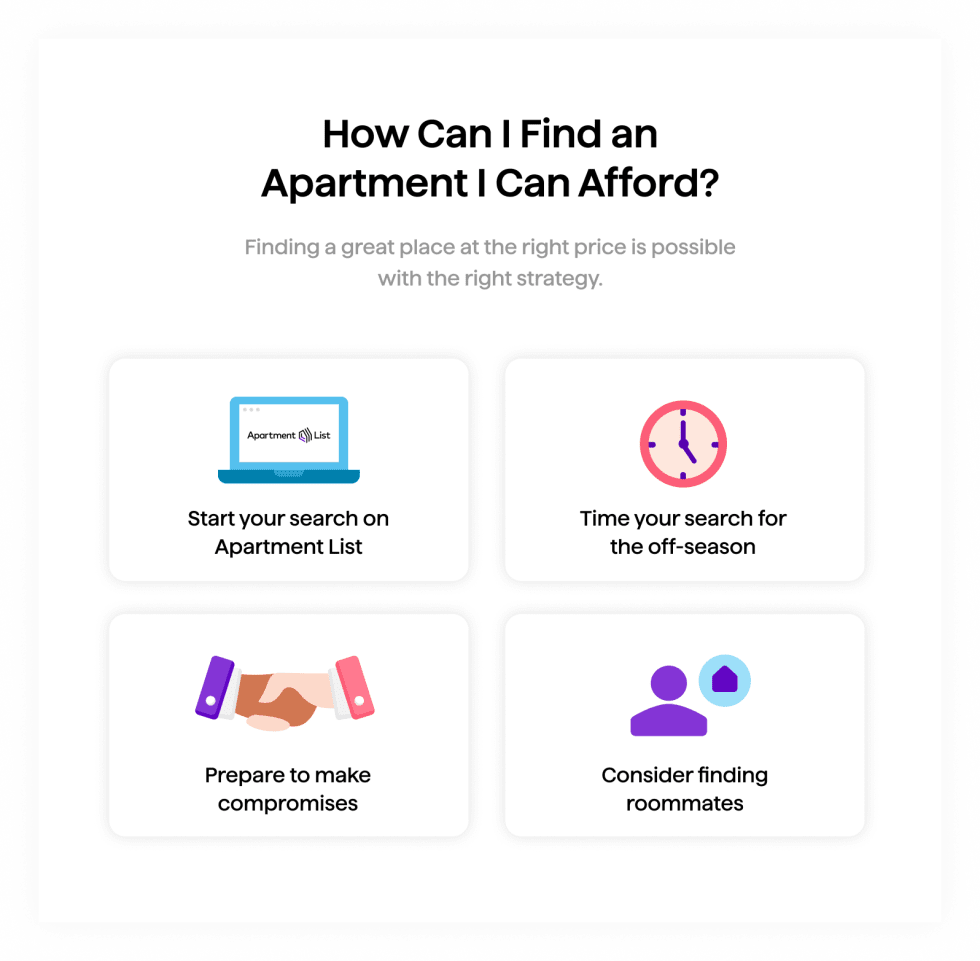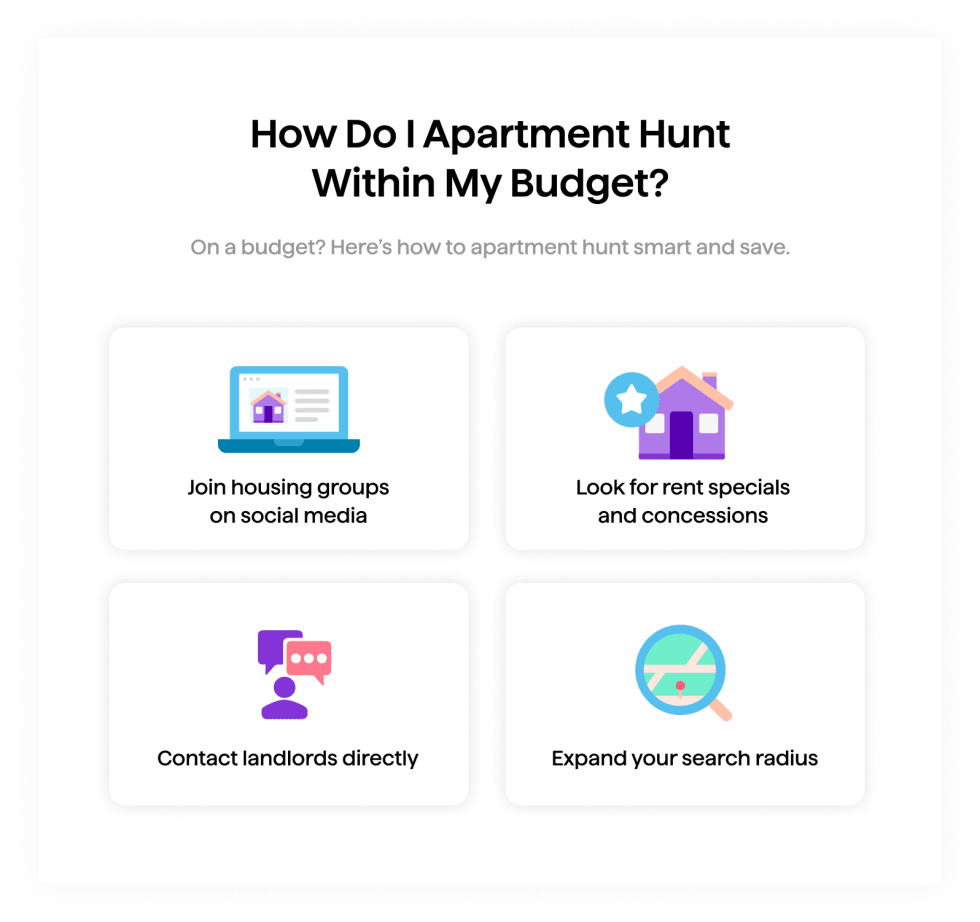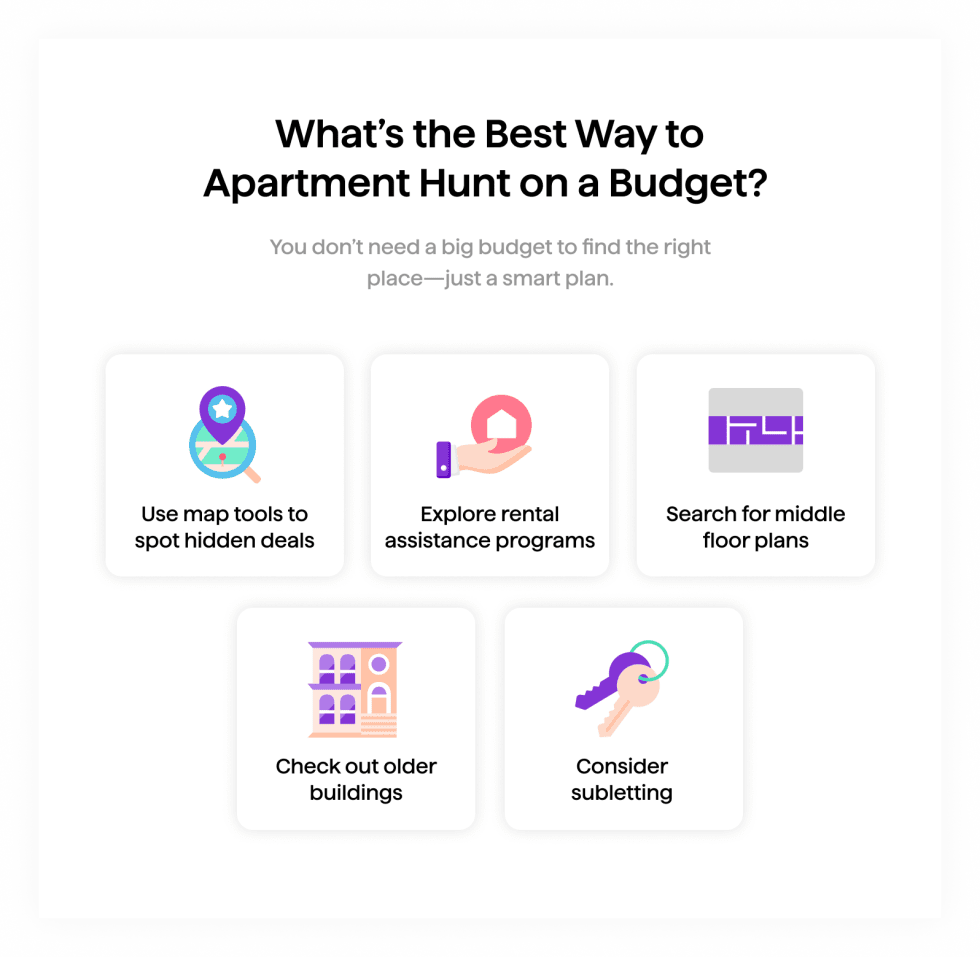The Pembroke
- 113 units available
- 1 bed • 2 bed
- Amenities
In unit laundry, Granite counters, Hardwood floors, Dishwasher, Pet friendly, 24hr maintenance + more

If you’ve ever wondered how to find an apartment in your budget or how to find an affordable apartment without sacrificing your must-haves, you’re in the right place. It’s important to define a realistic rent limit, factor in total housing costs, and use smart tools to narrow your search. It sounds simple, but too often renters underestimate expenses or fall for places that stretch their wallet too thin.
In this step-by-step guide, we’ll walk through how to set your apartment budget (and stick to it), how to filter listings with confidence, when to start your search, what hidden costs to watch out for, and how to negotiate a better deal. If you’ve ever wondered how to find an apartment in your budget without sacrificing your must-haves, you’re in the right place.
When it comes to finding an apartment that fits your budget, Apartment List is one of the best places to start. Unlike traditional listing platforms that flood you with hundreds of results, Apartment List uses a personalized quiz to match you with rentals that actually fit your needs, including your budget, preferred location, commute time, and must-have amenities.
Once you complete the quiz, you’ll get a curated list of options ranked by how well they match your priorities, helping you avoid wasting time on listings that exceed your budget for apartment living.
Another major is that you can track your favorite listings, get notified when prices change, and even compare places side-by-side.

One of the easiest ways to save money on rent is by timing your search for the off-season. The rental market tends to cool down between October and February, when fewer people are moving.
That drop in demand gives you more leverage. Landlords are often more flexible on rent, move-in dates, and fees just to fill vacancies before the year ends or during the winter lull. You might even find deals like a free month’s rent or waived deposits that are rarely offered during busier months.
In contrast, May through August is peak moving season. That’s when recent grads, families, and job relocations all converge, meaning more competition and fewer negotiable terms.
If you’re budgeting to move into an apartment, start your search during the off-season.
Unless you have an unlimited budget (lucky you), finding the perfect apartment usually means making a few compromises.
The key is knowing where you're flexible and where you're not. For example, would you trade in-unit laundry for a lower monthly rent? Could you live a bit farther from downtown if it means getting more space or utilities included?
Start by listing the things you can’t live without versus your nice-to-haves. Then, prioritize what will have the biggest impact on your budget. Often, small trade-offs like opting for a top-floor walk-up instead of an elevator building, or choosing an older unit with fewer amenities, can translate to significant monthly savings.
This is key to knowing how to budget for an apartment.
Compromising doesn’t mean settling. It means being strategic and focusing on what matters most to your day-to-day life while still landing a place that won’t stretch your finances too thin.
Finding a roommate (or two) is one of the most effective ways to bring your rent within budget. Splitting the cost of rent, utilities, and internet can cut your monthly housing expenses in half, or more, while opening the door to better locations or bigger spaces that would otherwise be out of reach.
Roommates aren’t just for college students, either. Plenty of young professionals and remote workers share spaces to keep costs manageable, especially in high-demand cities. Platforms like Roomies and social media groups make it easier than ever to find compatible, verified housemates.
Sometimes, the best rental deals never make it to the big listing sites. They’re posted directly in local housing groups on social media.
Facebook is especially useful for this. Search for groups like “NYC Housing,” “Los Angeles Apartments,” or “Chicago Roommates” and you’ll find thousands of real-time listings, often from individual landlords or tenants looking to sublet or fill a room fast.
These groups can be goldmines for below-market rentals, no-fee units, or short-term sublets, and many listings allow you to message the poster directly. That means faster communication and more flexibility on price, move-in dates, and lease terms.

If you’re only looking in the city’s trendiest or most central neighborhoods, chances are you’re overpaying. Knowing how to find cheap apartments often means simply expanding your search radius, even by just 20 to 40 minutes. Rentals just outside the downtown core often offer higher better value, with more space, lower rent, and quieter surroundings.
Focus on areas with strong public transit, bike paths, or easy highway access, so you’re not trading savings for long, painful commutes. Walkable neighborhoods just beyond the city limits can offer the same conveniences, like grocery stores, restaurants, and green space, without the inflated price tag.
Use map-based tools to explore rental heatmaps and compare average rent by neighborhood. A slightly longer commute could save you hundreds per month, and open up far more options.
One of the best-kept secrets in apartment hunting? Rent specials and move-in concessions.
Landlords and property managers often offer deals like “1 month free,” “no deposit,” or “reduced rent” to fill units quickly, especially during slower rental seasons or when leasing large buildings.
These deals can save you hundreds, even thousands, upfront, and in some cases, they reduce your effective monthly rent. For example, if you get one month free on a 12-month lease, that’s like getting an 8.3% discount on your rent each month.
When browsing listings, keep an eye out for phrases like:
Not all affordable apartments are miles away from where you want to live. Some are just a few blocks outside the pricier neighborhoods. That’s where map-based search tools come in.
By zooming out and scanning rent prices across zip codes or transit lines, you can spot hidden deals in areas that are still convenient but not quite as in-demand.
Rent can drop sharply just outside trendy hotspots, even if the walk to your favorite coffee shop or train station is only 5–10 minutes longer. Use tools that let you compare listings by neighborhood or draw custom search areas to target these edge zones.

Middle-floor units are often cheaper than top-floor or ground-level apartments. Why? They’re considered less desirable. There’s fewer views than the top floor, more noise than the highest or lowest levels.
And while they might not be considered the best apartment floor to live on, that can work in your favor when you’re trying to stay on budget.
Many property managers price units based on perceived demand. Top floors may come with premium pricing for the view or vaulted ceilings, while ground-floor units may cost more for easy access or outdoor space. Middle-floor units, on the other hand, tend to be the least expensive tier, even when the layouts and square footage are identical.
Bonus: Middle floors stay cooler in summer and warmer in winter, helping cut utility costs.
If your goal is short-term flexibility or deep savings, subletting can be a great option, especially in high-demand cities or during off-peak seasons. Sublets are often listed by tenants who are breaking a lease or leaving town temporarily, which means they’re usually more motivated to rent quickly and affordably.
You might find below-market rent, furniture included, or flexible move-in dates, all without the long-term commitment of a standard lease. In some cases, utilities or Wi-Fi may already be included, making budgeting even easier.
If you’re struggling to afford rent or just trying to stay ahead, it’s worth looking into rental assistance programs in your area. These programs can offer vital support for renters who are budgeting for an apartment on a limited income, especially during job transitions or unexpected emergencies.
Start with your local housing authority or city government website. You may qualify for:
Some programs are short-term (covering one-time rent or utility payments), while others offer long-term support tied to your income level.
Even if you don’t qualify now, getting on a waitlist can be a smart move. With rising rents in many cities, these programs can make the difference between scraping by and staying stable, and many renters don’t realize help is even available until they ask.
Newer apartments may look sleek and modern, but they often come with a higher price tag and added amenity fees. If you're trying to stay within budget, don't overlook older buildings.
These properties typically offer lower monthly rent for comparable square footage, especially in established neighborhoods.
While you might give up granite countertops or high-tech appliances, older buildings often come with larger floor plans, thicker walls, and more character. Plus, they're less likely to bundle in-costs for trendy amenities like rooftop decks or coworking lounges that you may never use.
Sometimes the best rental deals never make it online. That’s why it pays to contact landlords directly if possible, especially when dealing with smaller, independently owned properties.
Many mom-and-pop landlords don’t bother listing on big rental platforms. Instead, they rely on word of mouth, yard signs, or returning tenants to fill vacancies.
Finding the right place to live on a budget requires a little strategy and flexibility.
If you're expanding your search radius, timing your move, or looking for hidden deals, there are plenty of ways to master how to find an apartment in your budget without giving up what matters most.
For more renter-friendly insights, check out our guide on budgeting for an apartment.
If you’re ready to find a place that actually fits your budget, start your personalized search today with Apartment List. It’s fast, easy, and tailored to what you care about most.
Rent should be no more than 30% of your gross monthly income. For example, if you earn $3,500 a month, aim to spend $1,050 or less on rent.
Not always. Some rentals include basic utilities like water or trash, but electricity, gas, and internet are often separate. Always ask what’s covered before signing.
Yes. Rent is often negotiable, especially if the unit has been vacant for a while or you're moving during the off-season. It never hurts to ask.

In unit laundry, Granite counters, Hardwood floors, Dishwasher, Pet friendly, 24hr maintenance + more
In unit laundry, Patio / balcony, Granite counters, Pet friendly, Stainless steel, Walk in closets + more